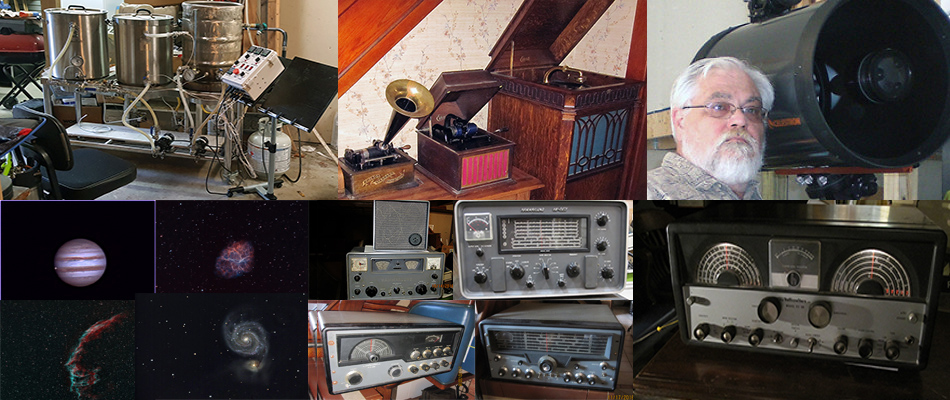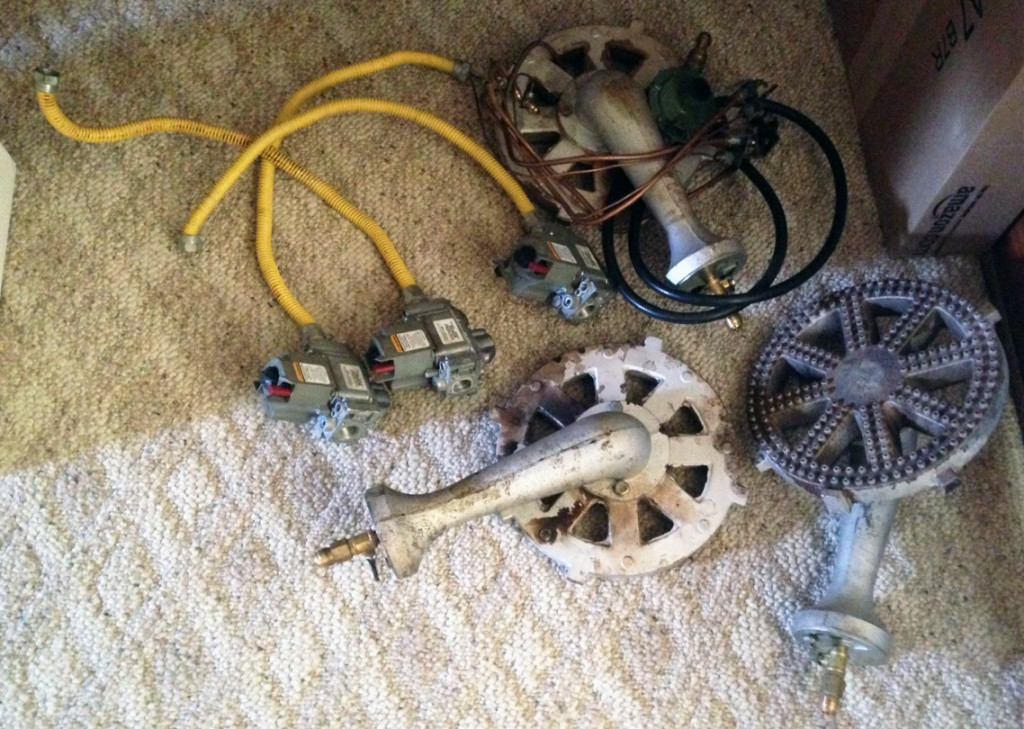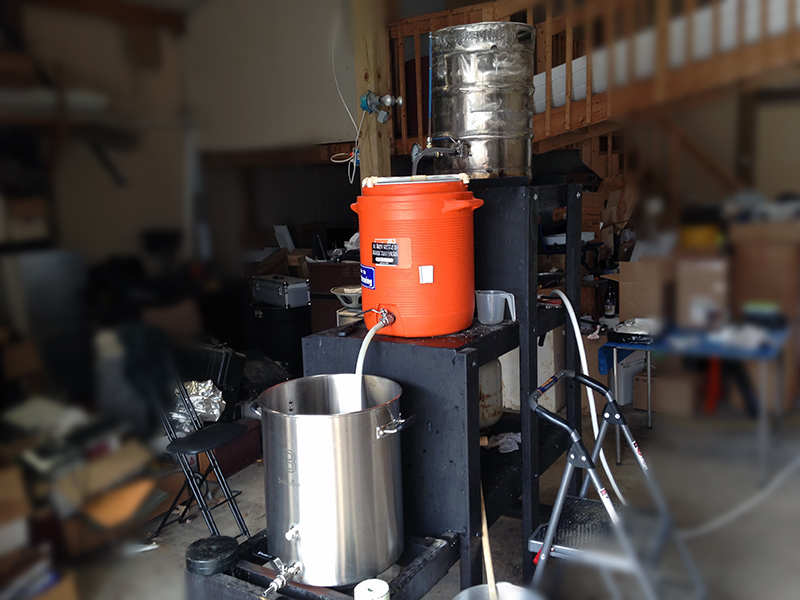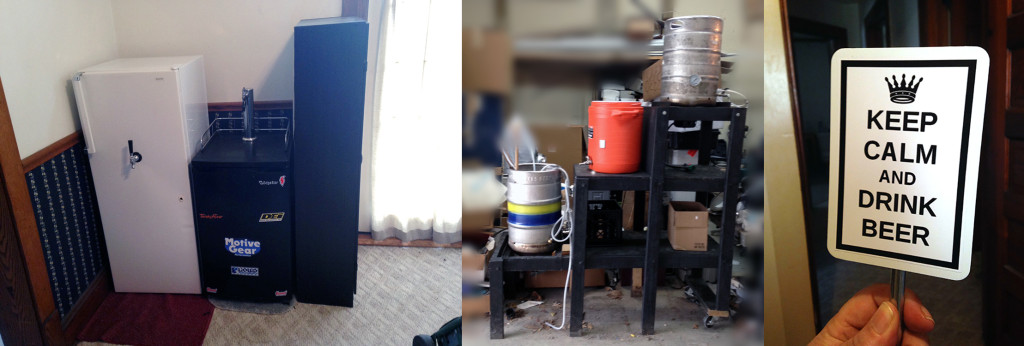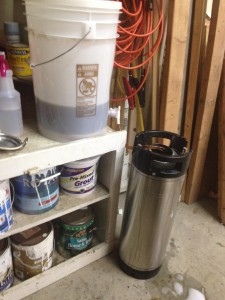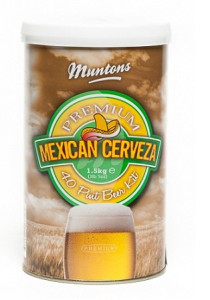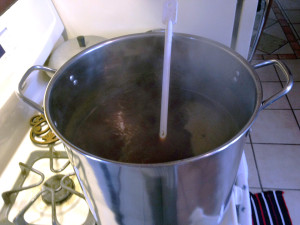
5-2-2015
First brew; 5 gallon batch, Vienna Lager partial extraxt kit from Grape and Granary in Akron, Ohio. the kit intentionally contained ale yeast despite the lager label. The guy at the store said it was as close to a lager as I would get without lagering; supposed to be similar to Dos Equis.
I used spring water from Beuhler’s; they had 2.5 gallon jugs. There’s a refill station there but I didn’t check pricing. I’ll probably keep using that until I can analyze my water. I have the Campden tablets to fix the choramine (and I can SMELL the choramine so there’s plenty of that) but don’t know about PH or minerals. I used Star San on everything and followed the advice I have seen about also loading up a spay bottle. That was a big help. If there was a hot break I missed it. The 5 gallon kettle contained the three gallon boil with no issues.
The steeping grains (the recipe doesn’t say what they are – the label probably did but that got thrown away) released a strong swampy odor. I don’t know whether that is normal. The odor filled the first floor and didn’t change after adding DME and LME, or even after adding hops and boiling for 45 minutes! Hope that’s OK.
Thought about rehydrating the dry yeast but since it’s a store kit I figured it was fresh enough so I just threw it in. Just took a look after about 6 hours and no airlock activity but a peek through the bung showed what appeared to be an even layer of krausen. I see why folks prefer to use clear carboys rather than the plastic buckets I have; can’t see what is going on in there.
Dunno about OG – checked it from the spigot and it was 1.100! That didn’t sound right so I pulled a sample from the top and it was 1.038. Kit said it should be 1.056. I realized that the makeup water hadn’t mixed well with the wort because of the different readings so I mixed it all up but forgot to take a new OG reading. I’m sure it is somewhere between 1.100 and 1.038!
Since everything was new, I put 5 gallons in the brew pot to boil and release whatever was in the metal. Stuck the wort cooler in there, too, for the same reason. Then used the chiller and dumped the resulting warm water. That was problematic; the damn adaptor doesn’t fit my ancient kitchen tap so I just held it on and let it leak. Fortunately I hadn’t made the water run yet so I picked up some ice while I was out. Used 10 pounds to chill the wort when the time came. Still have 10 pounds of ice and 5 gallons of spring water for the next brew.
It was a busy day. Took five or six hours from setup to pitching yeast and rinsing the hardware. I know a partial extract shouldn’t take that long, but I had to organize the stuff and boil the metal items. Next brew day will be easier. I think I’ll do a full (unhopped) extract next. AIH has a “Cervesa” kit by Muntons on sale (about half the price of the kit I used today). At least I won’t have to worry about the specialty grains smelling up the place. I also have a partial extract kit that came with some hardware I bought – but it is really old. I think it has only DME so might be OK if I replace the yeast. I’d hate to waste a 5 gallon batch, though. And there’s the Mr. Beer kit I bought when they had their big one day $20 sale a few weeks ago.
The stovetop is slow in bringing 5 gallons to a boil and not much faster with the three gallons boiled in the kit recipe. I’d like to get a nice, big burner for the barn. There’s gas out there so I wouldn’t have to fiddle with propane. That would help with the smell, too, if that is always going to happen. Since I’m apparently going to be using spring water, the barn may be ideal (no water lines to the barn). If I straighten things up out there and dump some junk I could have quite a large area dedicated to brewing. I keep it at 50 degrees in the winter out there (and can easily increase that to 70 degrees for a brew day) so it would be a decent environment. It gets HOT in the summer but a big fan and two open doors would probably handle that.
I have two 5 gallon ball lock kegs on hand and two more on the way (all new). Two will fit in the Edgestar kegerator, though only one tap is connected. I ordered a picnic tap to use on a second keg until I decide whether to switch to a two tap tower. The larger kegerator will handle three or four kegs and it will be easy and cheap to add additional taps to that one. I first have to decide whether it will remain a kegerator or become a controlled temperature fermentation chamber. I’m considering doing that and making a keezer to replace it. Right now the priority has to be getting the Edgestar prepped to accept this batch in time to accept it. I switched the beer and gas connectors over to ball lock so it’s ready to run one keg. I need to get a gas line in there for the second keg, and get the temperature adjusted. I plan to force carbonate right away, and then load up some bottles to pass around (if it is any good). Sure sounds easier than filling them from a bottling bucket and carbonating with sugar for a week or two.
